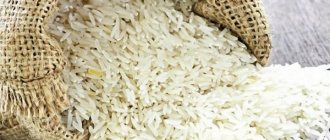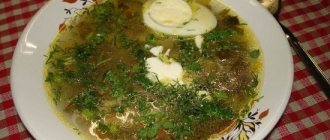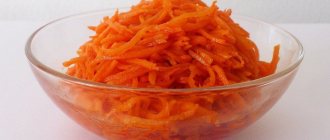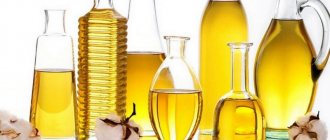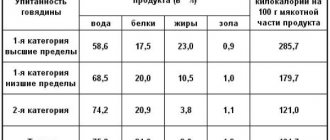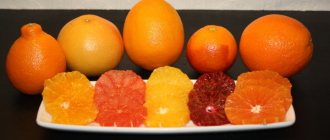Delicious sauerkraut is obtained as a result of pure lactic acid fermentation. Low calorie content ensures the product is useful for a healthy diet. National cuisines of many countries (Russia, Belarus, Korea, China) have their own recipes for preparing dishes, which are strikingly different from each other. For example, the Slavs in villages have long fermented whole heads of cabbage in oak barrels.
And in China and Korea they add a lot of spices. In historical documents dating back to the 3rd century BC, there is a mention of a useful product for feeding the builders of the Great Wall of China - “sauerkraut”. It regulates the functioning of the entire digestive system. Korea shared its national dish with the world - sauerkraut kimchi.
Among the Slavs, cabbage was part of the daily diet, regardless of the social status of the family. It was fermented shredded or whole (sometimes quartered) with the addition of sour varieties of apples or cranberries, lingonberries, cloudberries and plums. In Russia there is even a holiday that people call “Sergei kapustnik” (Sergius Day in the Orthodox calendar) on which they ferment cabbage.
How to prepare cabbage for pickling:
- shredded with mechanical devices into small chips;
- chop the leaves - obtained by cutting a head of cabbage with a knife;
- whole forks;
- salting with quarters without stalks.
To obtain a useful product, it is necessary to create conditions for the correct occurrence of biochemical fermentation processes. When they occur, beneficial bacteria on the surface of cabbage leaves ferment the sweet sugars of cabbage juice to form lactic and acetic acid. They prevent the development of putrefactive bacteria and the formation of mold.
If such products appear in a container with cabbage, the entire batch of product must be thrown away. To avoid this, it is necessary to provide the product with two conditions - temperature and removal of CO2 gases, which are formed during the fermentation process and liquefy and foam the cabbage juice.
Calorie content, BJU
Sauerkraut (which is low in calories) promotes digestive processes in the intestines, saturating it with an additional composition of lactobacilli. Cabbage is often introduced into the diet when taking antibiotics, as a preventive measure for intestinal dysbiosis.
During the period of proper natural fermentation in a lactic acid environment, cabbage is saturated with:
- vitamin A, which is involved in the production of collagen in the skin and improves the structure of weakened hair, which makes it the “vitamin of female beauty”;
- vitamin C, which fights the aging of body tissues and supports the immune system;
- a set of B vitamins that participate in the functioning of cells of the nervous system, improving sleep, relieving pain symptoms in myalgia and radiculitis;
- vitamin K, which is involved in the processes of bone tissue, contributes to their strength;
- unique vitamin U, which is found in large quantities in cabbage and stops the formation of ulcers and neoplasms in the gastrointestinal tract;
- iodine, which is necessary for the functioning of the thyroid gland and the entire endocrine system.
Calorie table for sauerkraut, BJU:
| Name of ingredients per 100 g | Quantity |
| calorie content | 19 kcal |
| squirrels | 0.8 mg |
| fats | 0 |
| carbohydrates | 1.8 mg |
Nutritional table:
| Name | Quantity |
| Saturated fats | 0 |
| Polyunsaturated fatty acids | 0.1g |
| Monounsaturated fatty acids | 0 |
| Cholesterol | 0 mg |
| Sodium | 661 mg |
| Potassium | 170 mg |
| Vitamin A | 18 IU |
| Vitamin C | 14.7 mg |
| Magnesium | 13 mg |
Sauerkraut.
Calorie content and chemical composition. The absence of fat in the product and the presence of vitamin U, which regulates the metabolism of digestive processes, make sauerkraut an essential component of diets when doing fitness.
Beneficial features
Sauerkraut has the following beneficial properties:
- strengthening the immune and nervous system, vascular walls;
- improving the condition of the gastric mucosa, skin, endocrine system and liver function;
- cleansing the intestines of toxic substances;
- decreased blood sugar levels;
- strengthening the nail plate, hair follicles and bones;
- relief from hangover and food poisoning.
Sauerkraut is more beneficial than fresh and pickled cabbage, since it contains more microelements. In addition, when it is fermented, lactic acid bacteria are formed, which help maintain intestinal microflora and eliminate dysbacteriosis. Regular consumption of pickles also reduces the risk of developing intestinal and stomach cancer.
It is useful to eat not only white cabbage in pickled form, but also a soup with its addition, known as sour cabbage soup. Since this first course has a fairly low calorie content, you can eat it while on a diet without the risk of gaining weight.
As a result of fermentation, juice is formed, which also benefits human health. This brine is often used as a diuretic to prevent the formation of kidney stones. Drinking cabbage juice has a beneficial effect on the condition of people suffering from diabetes, as it promotes the production of insulin. It helps normalize the functioning of the digestive system.
Cabbage brine is recommended for pregnant women to drink, as it is enriched with substances necessary for the proper development of the fetus. In the early stages, sauerkraut and its juice help alleviate toxicosis.
Classic recipe
Sauerkraut (calorie content of the finished product is about 10 kcal) is obtained by natural fermentation, without the addition of artificial catalysts for biochemical processes.
The classic recipe is easy to prepare, but a tasty end result may not work out for several reasons:
- Delaying the fermentation process: it occurs at room temperature, but it varies depending on the season. The ideal ferment temperature is considered to be 18-20°C, but not more than 3-7 days. Otherwise the cabbage will turn sour.
- Accumulation of gases inside the product: all layers of cabbage must be pierced daily to the very bottom to release gases accumulated in the lower areas, which will make the cabbage slippery and give it an unpleasant smell of hydrogen sulfide.
- The flow of excess air into the layers, without the use of oppression: the brine should cover the cabbage to the top.
- Lack of salt will not only affect the fermentation process, but will spoil the taste of sauerkraut; it cannot be added to the salt when serving. Iodized salt should not be used for fermentation.
- The wrong variety of vegetable was chosen: it is not recommended to use late varieties of cabbage for pickling in the fall. They are intended for long-term storage because they have a low amount of sugar in the structure of the leaves. When stored properly, they accumulate, so this cabbage can be pickled at the end of winter or early spring. Then the process will proceed with the production of the required amount of lactic acid.
Composition of ingredients
You can calculate the proportions of products for classic pickling of cabbage yourself. As a rule, they focus not only on the need for the product, but also on the container in which the cabbage will be fermented.
For 1 part cabbage (1 kg):
- carrots – 1/10 of the weight of the vegetable (100 g);
- 1 tbsp. l. salt;
- 0.5 tbsp. l. sugar (optional ingredient).
This minimum set of products is enough to produce sauerkraut through natural fermentation. However, modern housewives make their own additions to the basic proportions, introducing new components into the composition.
Today, the classic recipe for pickling cabbage is:
- head of cabbage without top leaves – 3 kg;
- carrot root – 2 pcs.;
- bay leaf – 2 pcs.;
- rock salt – 3 tbsp;
- black peppercorns – 4 pcs.
Step-by-step cooking process
Recipe:
- It is necessary to prepare the cabbage: wash, peel off the top leaves, cut into 2 or 4 parts, remove the stalk. Use a knife or food processor to shred the cabbage into thin strips. There are special shredding boards on which halves of large cabbage in any volume are chopped.
- Place chopped cabbage in a dry enamel container. It must be thoroughly kneaded with your hands.
- Next, mash the cabbage with the required amount of salt until the vegetable is soft. This procedure will combine the salt and cabbage and provoke the release of cabbage juice.
- The carrots must be washed with a stiff brush, peeled, and chopped on a coarse grater.
- If sugar is used in the recipe, add it to the grated carrots and mix thoroughly.
- Next, you need to mix salted cabbage and sweet carrots.
- Then you should lay out the vegetable mixture in layers in a container for sauerkraut. It is recommended to use enamel, glass or wooden utensils. The main requirement is to compact the layers thoroughly. However, it should be borne in mind that if soft cabbage is strongly compacted, it will be impossible to pierce it to the bottom to free it from carbon dioxide.
- After laying out the vegetables, a sufficient amount of juice should be released. It should cover the vegetables on top. If this does not happen, it is recommended to add cold boiled water to the top.
- Small containers (small pans, 3-liter jars) are placed on a tray to collect the cabbage juice flowing over the edge of the container. Even if there is a lack of liquid during initial installation, after a day there will be an excess of it in the dishes, which is pushed out by the escaping gases.
For a high-quality fermentation process, the room temperature should be about 16-18°C. The fermentation process will take about 3-5 days. Every day, be sure to pierce the vegetable mixture to the bottom in several places to release gases. After 2 days, a pleasant sour smell of brine should appear.
The appearance of the juice can indicate the progress of the fermentation process. After fermentation is complete, the container with cabbage is put into the cold. If pickling takes place in jars, you can hide it in the refrigerator. The period of completion of cold cooking takes 6-10 days.
What can I add?
Sauerkraut, which is very low in calories on its own, can be supplemented with other fruits and vegetables. They not only change the taste of the final product, but also affect the calorie content. Traditional pickling recipes add sour berries - cranberries, lingonberries, cloudberries.
Sauerkraut acquires an additional sweetish taste (without adding sugar) when adding fruits - green apples, plums, quinces. Recipes with vegetables - carrots, beets, pumpkin, sweet or bitter peppers - are considered traditional.
However, it should be remembered that bell peppers in a lactic acid environment will soften greatly and lose color, and an excess of hot peppers can make salted cabbage bitter.
Many cabbage recipes contain spices - peppercorns, cumin, cloves, coriander. They do not participate in the fermentation process, but affect the taste. Each spice has a specific flavor. To choose it, you need to try pickling in small batches and decide on your choice. Spices are placed between layers of vegetables when placed in a container.
From historical sources, recipes for sauerkraut without salt have survived to this day. Cabbage ferments well, but is not subject to long-term storage (it becomes covered with mold fungi). From which we can conclude that salt is not a fermentation catalyst, but a preservative for the finished product.
How to serve a dish
Before serving cabbage, it must be squeezed out of the brine. Traditionally, vegetable oil and onion half rings are added to the mixture. At the serving stage, it is recommended to add bell pepper cut into strips. If the sauerkraut tastes sour, you can add sugar and let it sit for about 2 minutes to dissolve.
The process of fermenting cabbage itself takes at least 1 week. A cold room is required to complete the fermentation. However, in cooking there are alternative recipes that allow you to shorten the cooking process.
Benefit
The beneficial properties of sauerkraut have a beneficial effect on many body systems, participating in strengthening, stimulating and regulating work:
- During fermentation, lactic acid bacteria actively multiply in the product, the benefits of which for digestion everyone has heard.
- Repeated studies have confirmed that sauerkraut is a more beneficial product for humans than fresh or prepared in any other way. This is explained by the fact that when boiling and stewing, the vegetable loses some properties and elements, and when fermented, it gains new ones.
- Other vegetables can boast a high content of potassium and iron, but cabbage is a rare specimen in which these elements are bound by vitamin P. Together, these substances strengthen the thinnest and most distant vessels - capillaries, and reduce their permeability. The result is an improved supply of all body tissues through the blood.
- Sauerkraut is enriched with many antioxidants that prevent cancer processes.
- The antiparasitic properties of this dish help expel parasites. The increased effect is noticeable when consumed simultaneously with tomato juice.
- During fermentation, lactic and acetic acid appear in the vegetable leaves and juice. The first is mistaken by doctors as an enemy, allegedly leading to muscle cramps and similar problems. This is not so, lactic acid is necessary for a person to effectively absorb carbohydrates, natural production of glucose and glycogen. And acetic acid improves the transfer of oxygen from the blood to the cells.
- Vitamins and microelements have a complex effect on the nervous system, preventing the occurrence of nervous tension, stress injuries, sleep disorders, and irritability.
- A group of B vitamins in combination with ascorbic acid and antioxidants effectively prevents the aging of skin cells, loss of muscle tone, and strengthens hair, skin and nails.
- Rarely found in foods, tartronic acid is a natural inhibitor of the conversion of carbohydrates into stored fat, which is very important for losing weight and preventing excess weight.
- The ability to stimulate water-electrolyte balance and the high content of vitamin C make it possible to use sauerkraut for hangover syndrome.
Quick sauerkraut recipe
Compound:
- white cabbage – 1 medium-sized head (1.5-2 kg);
- garlic – 3 large cloves;
- carrots – 2 large carrot roots;
- vegetable oil – 100 g;
- 9% vinegar (apple vinegar is possible) – 80-100 ml;
- sugar – 100 g;
- water – 0.5 l;
- salt – 1-2 tsp.
Step-by-step cooking process
Recipe:
- First you need to wash and chop the cabbage into small strips. Only the leaves should be used for slicing; the stalk should be cut out.
- The carrots need to be grated on a coarse grater. You can chop carrots using a Korean carrot grater.
- In a separate container, you need to chop the garlic through a press.
- Bring the volume of water specified in the recipe to a boil.
- Next, you should dissolve vinegar, salt, sugar and vegetable oil in water.
- Then you need to mix the carrots, cabbage and garlic in an enamel container. Pour in hot brine.
- It is necessary to install oppression on top, maintain a minimum time of 3 hours, but the best result is achieved after a day.
According to this recipe, cabbage is served without pre-squeezing and adding oil, since the marinade will act as a sauce. The cabbage is laid out by scooping it with brine.
Recipe for pickled cabbage and beet salad
When choosing this recipe, remember that after fermentation, the salad turns pink. The intensity of coloring depends on the amount of pigment in fresh beets.
Composition of ingredients
Compound:
- cabbage (net weight with stalk) – 2 kg;
- beets – 2 small roots with a total weight of 200-300 g;
- water - 800 ml;
- granulated sugar – 2 tbsp;
- table vinegar (9%) – 20 ml;
- bay leaf – 3 pcs.;
- salt 1 tbsp;
- peppercorns, coriander or cumin as desired.
Step-by-step cooking process
Recipe:
- The cabbage must be washed with running water and dried with towels.
- Then you need to remove the stalk and divide the head of cabbage into 8 parts, which are cut with a knife into large squares of irregular shape.
- The beets must be washed and also cut into thin slices using a knife. For an attractive appearance of the salad, the size of the beet slices should match the size of the cabbage leaves.
- Dissolve salt and sugar in the required amount of water, add spices and bring the brine to a boil.
- Then it should be kept in a boiling state for 10 minutes. and pour in the vinegar, then remove from the heat.
- You need to mix cabbage and beets in a large container and pour in the hot marinade. It should cover the salad completely.
- The top of the container is covered with gauze to provide oxygen access and protect it from foreign particles.
- Next, you need to keep the container with cabbage in a warm place for 4 days.
After fermentation, the salad has a beautiful pale pink color and a sweetish-spicy flavor. The pungency is minimal, only due to fermentation. In addition to healthy and tasty cabbage, beet slices are also eaten.
Effect on weight loss
Sometimes the properties of sauerkraut indicate its low calorie content as the main benefit for combating excess weight.
100 grams contain only 19 kcal. But since strict calorie counting for weight loss is not at all the main thing, the main influence on the process of weight normalization is associated with completely different features of the product. The main beneficial quality is the content of a significant amount of probiotics together with prebiotics.
Why is this so important?
- An imbalance of intestinal microflora leads to weakened immunity and the development of chronic inflammation, which scientists consider one of the causes of excess weight gain. There is a hypothesis that a person, in principle, cannot have a normal weight if his intestinal flora is not in order. He may be excessively fat or suffer from thinness, but he will not be able to have a normal weight.
- People with altered microflora usually show signs of overeating and addiction to sweets. This is due to the fact that many pathogenic bacteria in the intestines need sugars for their existence and therefore send calls to their host’s brain to eat sweets.
- Some pathogenic bacteria stimulate the development of insulin resistance, which quickly leads not only to excess weight gain, but to a whole bunch of other serious diseases.
Without normalizing the functioning of the intestinal biocenosis, it is difficult to lose weight. The correct and effective way to optimize microflora is to use probiotics. And not in tablets, but in natural living form, that is, in food products.
Probiotics are found in all foods that have been prepared using traditional fermentation. These are fermented milk dishes, for example, kefir, and fermented vegetables.
Fermented milk microorganisms in sauerkraut are much more effective than probiotics from dairy products. The explanation is this: beneficial bacteria in cabbage are in a more acidic environment than in kefir or yogurt, and, therefore, more effectively overcome the stomach with its acid and enter the intestines alive.
In addition, sauerkraut has a successful combination of probiotics and prebiotics. Prebiotics are food components that are not broken down in the upper parts of the digestive system, but are successfully absorbed in the large intestine by the bacteria living there. These compounds are absolutely necessary for the life of lactobacilli, and therefore their presence in the product is a big plus.
However, you should not switch to some special “sauerkraut” diet and try to lose weight exclusively on this product, abandoning all others. This approach may lead to rapid weight loss, but the weight loss will not be sustainable. And it will develop into further weight gain. As always happens with strict diets.
Quick starter cabbage without vinegar
For people who have problems with the gastrointestinal tract, a recipe without the use of vinegar is suitable. It contains a large number of vegetables, which makes it indispensable when creating a menu for weight loss.
It is eaten as a mono-dish and taken for one meal.
Composition of ingredients
Compound:
- forks of white cabbage – 1 kg;
- zucchini (without seeds) – 150 g;
- medium-sized tomatoes - 3 pcs.;
- sweet pepper – 3 pcs.;
- parsley – 20 g;
- garlic – 2 cloves;
- carrots – 2 pcs.;
- water 0.5 l.;
- If desired, you can add dill or cilantro.
Step-by-step cooking process
Recipe:
- Before placing cabbage in a container for fermentation, it is subjected to preliminary heat treatment. The cabbage head is cut into 4 parts and the stalk is removed. The quarters are immersed in boiling water for 3 minutes.
- Tomatoes are cut into cubes.
- Grate the carrots on a coarse grater.
- Zucchini is cut into cubes the same size as tomatoes.
- Sweet peppers are chopped into strips.
- Next, you need to boil water and add salt to it.
- Lay vegetables in a glass container: cabbage, carrots, zucchini, tomatoes, peppers. Each layer should be sprinkled with a small amount of chopped garlic.
- Next, you need to compact the layers tightly in the container and fill it to the top with hot brine (the liquid should not be boiling).
- Then you should set the oppression and leave it to ferment in a warm place (20-22°C) for 4-5 days.
The duration of the fermentation process depends on the room temperature. When foam is released, it is removed. When active bubbling stops, the brine acquires a delicious sour smell and taste - the fermentation process is considered complete. It is recommended to store the container with vegetables in the refrigerator to avoid over-acidification of the vegetables.
Contraindications and side effects
The amount of sauerkraut in your diet must be rationed. Excessive consumption is fraught with the development of a number of undesirable reactions:
- Increased blood pressure and development of edema. The intake of large doses of table salt into the body leads to an increase in water absorption at the level of the kidney tubules and an increase in the volume of intravascular fluid. The effect is scientifically proven.
- Increased acidity of gastric juice. It is not recommended to eat sauerkraut for any inflammatory lesions of the stomach and duodenum, peptic ulcer, gastroesophageal reflux disease.
- Decreased functional activity of the kidneys. Sauerkraut is contraindicated in kidney disease with decreased filtering or reabsorbing capacity (CKD).
- Flatulence. When consuming more than 200 g of product per day, the processes of fermentation and putrefaction in the intestinal lumen are activated.
It is extremely important to limit your consumption of the product and, if necessary, consult a doctor to avoid harm.
Menu for diet
Nutritionists recommend using sauerkraut salads for one-day fasting. They provide a sharp reduction in daily calories and activate intestinal motility, which allows you to cleanse the body of toxins. A recipe for making cabbage salad without vinegar is recommended for one-day fasting for people suffering from gastritis or high acidity.
Sauerkraut (the calorie content of the product does not increase after fermentation and is about 10 kcal) is a mandatory ingredient in diets for active fitness activities aimed at losing weight. It is able to satisfy hunger without adding extra calories. Introduces a set of useful vitamins into the body and accelerates metabolic processes for processing adipose tissue.
However, there are a number of contraindications to the use of sauerkraut in the diet:
- increased stomach acidity;
- chronic kidney disease in the acute stage of the inflammatory process;
- peptic ulcer of any part of the gastrointestinal tract;
- surges in blood pressure with increased readings;
- tachycardia.
To maintain normal weight, it is enough to eat cabbage salads (with beets or a set of pickled vegetables, the recipes for which are given above) as a side dish. Within a month, even weight loss may be observed, which indicates the normalization of intestinal function. This will not happen if you eat cabbage with fatty fried meat or sausages.
All spicy, fried and high-calorie foods should be excluded from the diet. When losing weight, nutritionists recommend developing a menu for yourself according to the recommendations:
Light diet for 3 days
Peculiarities:
- breakfast consists of oatmeal (200-300 g) and a glass of sauerkraut brine;
- lunch: pancakes with sauerkraut added to the dough, cooked in a minimum amount of vegetable oil or boiled chicken breast (250 g) with the addition of sauerkraut-based salad (unlimited quantity);
- For dinner, prepare stewed ocean fish (200 g) and sauerkraut (fish can be replaced with an omelette of 2 eggs).
Strict diet for 3 days
Recipe:
- for breakfast, green tea and a slice of black bread (baked goods without yeast);
- lunch: sauerkraut salad (300-400 g) and apple or pear;
- for dinner (until 18.00) boiled fish fillet (can be steamed) and sauerkraut (300 g);
- Before going to bed, you can drink 1 glass of low-fat kefir (preferably 0%).
It is recommended to include in long-term diets based on sauerkraut:
- boiled chicken meat;
- egg omelet or poached eggs;
- boiled vegetables (except potatoes);
- porridge – oatmeal, rice, buckwheat, pearl barley;
- ocean fish, stewed or steamed;
- green tea, yogurt and kefir (0% fat), sauerkraut brine.
To achieve better results, you need to divide your meals into 5 times a day, while significantly reducing the size of portions. This principle is especially important for long-term diets. As a result of such nutrition, the body and brain do not feel hungry, and the digestive system gets used to smaller amounts of food.
There is an opinion that especially tasty sauerkraut is obtained if pickling is carried out according to the lunar calendar. This Old Slavonic tradition has taken root in our time. The best time for salting is considered to be the period during the waxing phase of the Moon. It must be in the constellations Aries, Taurus or Capricorn. According to legend, it is this type of cabbage that is stored for a long time without losing its taste.
When shredding, be careful about the thickness of the slices. Don't make thin shavings. Modern housewives use mechanical vegetable cutters or food processors, which allow you to adjust the thickness of the slices.
Cabbage should be stored in the container in which fermentation took place. The ideal temperature for long-term storage of sauerkraut is 5°C. Under such conditions, the product can be stored for up to 1 month. and longer. When storing and using, you must ensure that the brine covers the top of the cabbage. Otherwise, the vegetable will darken and begin to dry out.
The low calorie content of the salad makes sauerkraut a must-have when losing weight or playing sports. The presence of unique vitamin U in cabbage makes vegetable salad useful in the diet for the prevention of colitis and ulcers.
How to use - 4 rules
Below are basic tips for consuming sauerkraut that will help you achieve maximum effect:
- Consider the amount of salt. 100 g of sauerkraut contains half the daily requirement of table salt. Excessive salt consumption can lead to the development of edema and increased blood pressure. Therefore, do not eat more than 100-150 grams of cabbage per day. You should also not drink sauerkraut juice (pickle) due to its high salt content.
- Eat cabbage between meals (as a snack). It has extremely low energy value and quickly makes the body feel full, so during the main meal you will eat less. You are allowed to reheat the dish before eating (40 seconds in the microwave).
- Add it to lunch and dinner. Cabbage goes perfectly with any protein products, especially chicken breast and other dietary meats. It will additionally enrich the body with fiber, which is extremely important for losing weight, maintaining intestinal microflora and overall health. It is also important to take into account that pickled cabbage cannot be combined with any fatty foods; neglecting this rule can lead to the appearance of dyspeptic disorders (flatulence). Due to its low calorie content, sauerkraut can be eaten in the evening for dinner, or even at night.
- Drink more water. You should additionally take about 600 ml of liquid for every 100 g of sauerkraut per day. This will remove excess salt from the body and increase the amount of cabbage that can be eaten per day to 240 g per day.
Proper use of sauerkraut is a simple task. The main thing is to normalize the amount of salt in your diet and drink more water.
